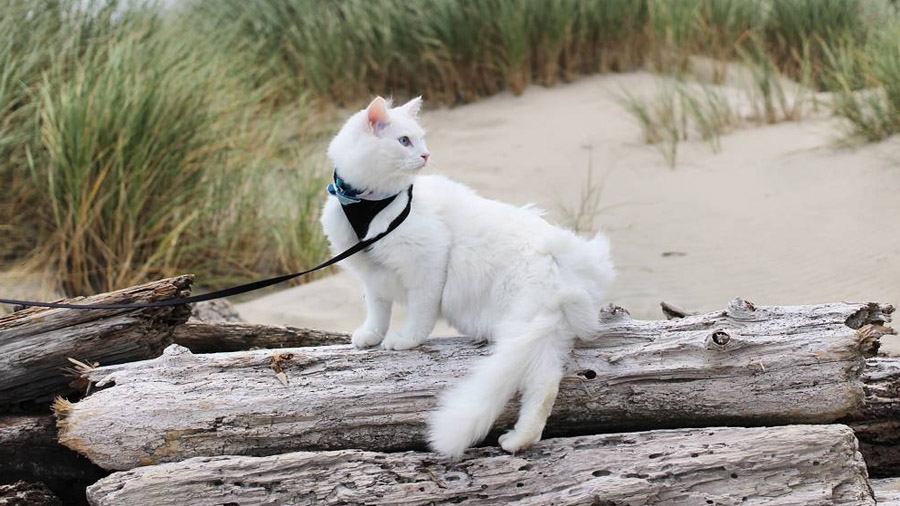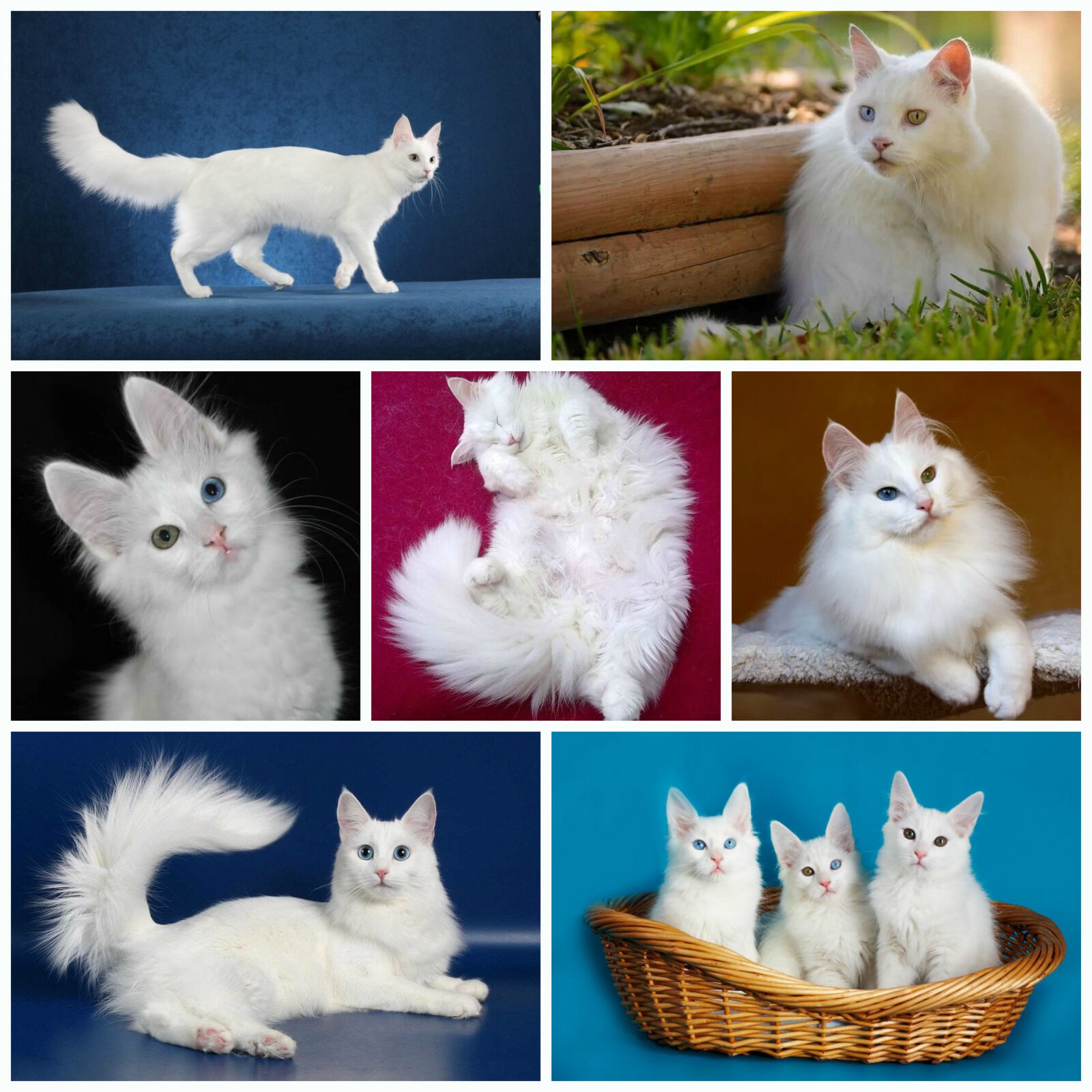
Краткое описание породы
Тело турецких кошек мускулистое, ноги длинные, задние чуть длиннее передних. А вот лапки совсем небольшие, округлые и изящные, часто с присутствием пучков шерсти между пальцами. Длинный хвост ангоры сужается к узкому кончику.
Красоту турецкой кошки подчеркивает клиновидная голова среднего размера, увенчанная большими, высоко посаженными ушами, на которых нельзя не заметить причудливые хохолки.
Выразительные миндалевидные глаза завершают невероятный образ турецкой ангоры. Их окрас может быть разнообразным: голубой, зеленый, золотистый, янтарный, разноцветный (каждый глаз разного цвета).
Турецкие ангоры могут быть небольшого или среднего размера, а их вес, в среднем, может варьироваться от двух до четырех килограммов. Средняя продолжительность жизни — порядка восемнадцати лет.
Красивая и элегантная турецкая кошка ангора часто удивляет своих владельцев необычайным интеллектом и атлетизмом. Для кошек этой породы практически нет никаких преград. Они могут взобраться даже на самый высокий в доме шкаф. Членам семьи также придется быть предельно осторожными во время закрывания межкомнатных дверей, так как они относятся к излюбленным местам времяпровождения ангорских кошек. Необходимо следить за тем, чтобы не защемить домашнему любимцу лапки.
Несмотря на то, что турецкие кошки, как их порой называют, могут отличаться превосходными манерами, они могут проявлять чрезмерную активность и подвижность. Домашние питомцы этой породы обожают интересные, активные игры. Они будут делать все возможное, чтобы сконцентрировать внимание окружающих на себе, даже если это будет вызывать у членов семьи раздражение или даже негодование.
Основная информация
| Название породы: | Турецкая ангора |
| Страна происхождения: | Турция |
| Время зарождения породы: | 1973 год |
| Вес: | 4 – 7 кг |
|
Код EMS:
|
TUA |
| Продолжительность жизни: | 16 – 18 лет |
| Цена котят: | 100 – 200 $ |
| Самые популярные клички: | список кличек для турецких ангор |
Оценка характеристик породы
|
Адаптивность
(Определение, означающее, насколько легко кошка может приспосабливаться к изменениям в жизни)
|
🐱🐱🐱🐱🐱 |
|
Уровень линьки
(Уровень и частота выпадения волос у животного)
|
🐱🐱 |
|
Уровень нежности
(Уровень и количество нежности и ласки, которую кошка отдает взамен на внимание к себе)
|
🐱🐱🐱🐱🐱 |
|
Социальная потребность
(Необходимое количество контактов кошки с другими животными, а также людьми)
|
🐱🐱🐱🐱🐱 |
|
Груминг
(Количество купаний, расчесываний, а также необходимое количество сеансов профессионального груминга, необходимого кошке)
|
🐱🐱 |
|
Дружелюбность в незнакомой среде
(Особенности поведения кота в обществе с незнакомыми людьми или в незнакомой обстановке)
|
🐱🐱🐱🐱🐱 |
|
Вопросы здоровья
(Потенциальный уровень состояния здоровья кошки)
|
🐱🐱 |
|
Интеллект
(Способность кошки к мышлению и решению возникающих трудностей)
|
🐱🐱🐱🐱🐱 |
|
Дружелюбность к детям
(Фактор, определяющий насколько кошка дружелюбна к детям, любит ли она с ними играть и терпеть некоторые детские шалости)
|
🐱🐱🐱🐱 |
|
Игровая активность
(Понятие определяется самим его названием, и, как правило, встречается почти у всех кошек)
|
🐱🐱🐱🐱🐱 |
|
Дружелюбность к собакам
(Склонность кошки находить общий язык с собакой)
|
🐱🐱🐱🐱🐱 |
Фото кошки Турецкая ангора:

История кошки Турецкая ангора
Длинношерстная ангорская кошка — это не источник для изготовления известных свитеров из ангоры, как некоторые могут подумать, услышав столь знакомое, на первый взгляд, слово. Хотя мягкость их шерсти можно сравнить с нежными свитерами из ангоры. Свое название порода приобрела благодаря турецкой столице, Анкаре, которая ранее была известна под названием «Ангора».
На протяжении многих столетий турецкая кошка ангора была своего рода сувениром для захватчиков и просто иностранцев, посещавших эту страну. Некоторые предполагают, что ангорская кошка стала первой длинношерстной кошкой на территории современной Европы, завезенной сюда викингами более тысячелетия назад. Со временем популяция кошек этой породы стала стремительно снижаться. Породу удалось спасти только благодаря специальной программе размножения, начатой в зоопарке Анкары.
В Соединенные штаты турецкая кошка ангора попала в 1954-м году. Заводчики сразу же заинтересовались породой, но ее не признавали до шестидесятых годов прошлого века. Ассоциация любителей кошек зарегистрировала породу в 1968-м году, а полное признание турецкой ангорской кошки произошло в 1972-м году. А вот что касается разноцветных кошек этой породы, то они были признаны лишь в 1978-м году. Отметим, что на сегодняшний день эта порода все еще не признана большинством североамериканских ассоциаций.
Характер кошки Турецкая ангора
Турецкие кошки ангоры сохраняют невероятную игривость и активность даже в достаточно зрелом возрасте. Они весьма дружелюбны к гостям и другим незнакомцам и питают невероятную любовь к своим близким. Кошки этой породы очень общительны, поэтому лучше всего приобретать эту ангору, если в доме есть другой котенок или собака. В таком случае ваш питомец никогда не заскучает и всегда будет в компании друга.
Когда вы находитесь дома, ангора с удовольствие может взобраться на плечи или на колени, чтобы провести там несколько минут. А вот ночью, вероятнее всего, ангорская кошка облюбует себе тепленькое местечко в вашей постели.
Для того чтобы ваша жизнь и жизнь вашего питомца была интересной и вызывала только позитивные эмоции необходимо обладать неплохим чувством юмора и безграничным терпением. Если же вы не готовы к таким условиям, то с приобретением ангоры лучше повременить или вообще отказаться от идеи содержания питомца этой породы.
Если ангорская кошка что-то задумала сделать, то очень сложно заставить ее не делать этого. Турецкая кошка ангора — это ласковый, нежный питомец, преданный своей семье и отличающийся настойчивостью, невероятной активностью, умом, стремлением к общению с окружающими и безумным желанием находиться в центре внимания.
Содержание и уход
За счет того, что у турецкой ангоры нет подшерстка, ее шерсть однослойная. Поэтому у питомца не возникают катыши на шерсти и за ней довольно просто ухаживать. Достаточно лишь еженедельного расчесывания. Приятно и то, что турецкая кошка не склонна к обильной линьке. Своей полной длины шерсть достигает лишь к двухгодичному возрасту.
Чистка зубов относится к обязательным еженедельным процедурам. Это позволит предотвратить возникновение у питомца пародонта и других стоматологических проблем. К еженедельным процедурам также следует отнести подстригание когтей, хотя у некоторых кошек они стачиваются естественным образом.
Не стоит забывать и о глазах, уголки которых каждую неделю нужно протирать влажной тканевой салфеткой с целью удаления всех возможных выделений. Для предотвращения возможной инфекции лучше всего использовать отдельную салфетку для каждого глаза.
Особое внимание уделяется ушам. Каждую неделю их нужно тщательно осматривать на предмет возникновения инфекций, загрязнений и раздражений. Ушные раковины лучше всего обрабатывать специальными салфетками, смоченными раствором, назначенным ветеринаром. Но также можно взять и раствор уксуса и воды в пропорции 1:1. Избегайте использования ватных тампонов при обработке ушных каналов.
Чистый лоток позволит избежать не только инфекционных заболеваний, но и будет условием отсутствия неприятного запаха в доме. Необходимо быть внимательным и не позволять питомцу без присмотра гулять на улице. Во-первых, вы предотвратите бесконтрольный контакт питомца с дворовыми животными, а во-вторых, будете уверенны в том, что домашний любимец не попадет под машину или не станет жертвой вора.
Представители этой породы обожают детей, особенно любят с ними играться. Поэтому они отлично подойдут для семей, в которых есть маленькие дети. Лучше не оставлять маленьких деток без присмотра. Они могут потянуть животное за шерсть и сделать ему больно, в свою очередь кошка может ненароком поцарапать ребенка.
Неплохо уживаются ангоры и с другими домашними любимцами. Если в вашем доме есть питомцы, кроме самой турецкой кошки, то необходимо проводить раннюю социализацию и приучать животных к совместному проживанию.
Здоровье и болезни
Турецких кошек ангора можно отнести к условно здоровым кошкам, отличающихся продолжительной жизнью, но и у них встречаются характерные заболевания. У ангор белого цвета с одним или двумя глазами ярко-голубого цвета часто встречаются проблемы со слухом или полная глухота одного или сразу обеих ушей.
Атаксия – нервно-мышечное заболевание. Оно приводит к гибели животного. Недуг поражает в основном маленьких котят в возрасте от двух недель до месяца. Проведение детального скрининга позволяет значительно сократить вероятность заболевания у потомства и уже рожденных котят.
Гипертрофическая кардиомиопатия является одной из разновидностей кардиологической патологии, приводящей к изменению сердечной мышцы. Эта болезнь одинаково распространена как у породистых, так и у дворовых кошек. Турецкие ангоры склонны к возникновению упомянутого заболевания, как ни какая друга порода кошек.
Несколько интересных фактов
- Название породы возникло благодаря столице Турции — Анкаре, которую некогда называли «Ангора».
- За турецкими кошками очень легко ухаживать.
- Ангора подойдет активным семьям.
- Кошки этой породы уживаются с собаками.
- Турецкие кошки склонны к кардиологическим проблемам.
Питомники и заводчики
Материал мы заимствовали с замечательного сайта наших партнеров DOGCATFAN.COM о кошках и собаках, автор dogcatfan
